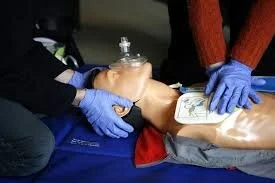Airway maneuvers, which include positioning the head so the airway is unobstructed and mouth-to-mouth ventilations, can be technically challenging and require interruption of chest compressions. Therefore, the untrained rescuer will provide Hands-Only (compression only) CPR.” It is estimated that survival rates for cardiac arrest decreases by 10-15% for every minute without CPR. The “Chain of Survival” concept of early access, early CPR, early defibrillation, and early advance care describes the interrelated actions required to improve survival from cardiac arrest. A clear time sensitive relationship between initiating CPR and survival exists. In 17 cities world-wide where survival rates were compared between early CPR (initiated by bystanders) and delayed CPR (initiated by EMS), the average difference between early CPR and late CPR was 4 minutes. Patients who received early CPR were between 2 and 11 times more likely to be discharged from the hospital alive compared to those who received delayed CPR.
Early CPR
The provision of early CPR to a victim of cardiac arrest is a key link in the Chain of Survival. In order to maximize survival, multiple studies since the 1960s have been undertaken to examine the methods and procedures used in out-of-hospital cardiac arrest. One consistent finding in what is a large body of literature, is that survival rate decreases dramatically the longer the patient is in cardiac arrest without CPR. In CPR, external chest compressions mechanically produce blood flow while artificial respirations provide oxygen to that blood. CPR is intended as a temporary measure to allow delivery of oxygen to the brain and heart until the cause of the cardiac arrest can be reversed. The ultimate goal is for the patient to have a functioning brain once the cause of their illness is identified and corrected.
While the exact rate varies from study to study, it is estimated that for each minute a patient is in cardiac arrest without CPR, the chance of survival drops by 10-15%.2 Across a large number of patients in 17 different cities across the world, a victim of cardiac arrest was between 2 and 11 times more likely to survive if CPR was initiated shortly after sustaining cardiac arrest.
Bystander CPR
Through resuscitation research it was recognized that many people are uncomfortable providing mouth-to-mouth ventilations and that the rate of bystander CPR increased when bystanders were instructed to provide chest compressions only. In fact, the 2010 American Heart Association guidelines changed the focus away from providing ventilations to providing excellent chest compressions. Delayed airway management/ventilation techniques for the first few minutes of cardiac arrest was recommended, as it was recognized that in most victims of cardiac arrest, a sufficient amount of oxygen existed in the blood to provide oxygen to the brain and heart for the first several minutes of cardiac arrest.
Cardiopulmonary resuscitation medical expert witness specialties include emergency medicine, anesthesiology, EMT, critical care medicine, and surgical critical care medicine.

